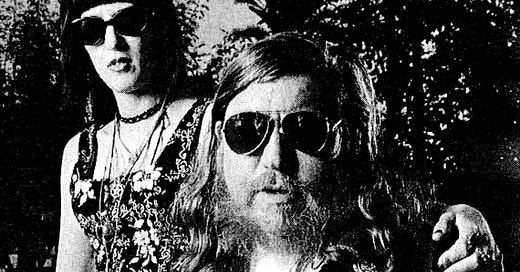Karl Edward Wagner: An Appalachian Agathocles
The Beer-Swillin', Hell-Raisin', & Pugnacious Hero of Neo-Pulp Literature
Once upon a time, Agathocles of Syracuse dominated Siculo-Greek civilization for twenty-five years. Ambitious, vain, and obsessed with becoming the Alexander the Great of southern Italy and North Africa, Agathocles was a democratic tyrant who not only stormed the walls of mighty Carthage, but also attacked Syracuse’s conservative oligarchy until, ultimately, he seized power and proclaimed himself monarch.
Not bad for the son of a simple potter, right?
Machiavelli characterized Agathocles as a consummate criminal—a black magick prince who used infamy and the infantry to wrest control from his supposed betters. Agathocles was a cad, a rebel, and a usurper. Had he been born in the U.S., Agathocles would have been a populist rabble-rouser—the kind of guy to crash all the snob parties and piss on the rug.
Karl Edward Wagner (1945-1994) was also that kind of guy, although he probably had better manners. Born and raised in Knoxville, Tennessee, Wagner grew up in ancient Appalachia as the son of a TVA official. Wagner attended Kenyon College in the 1960s before pursuing a M.D. in psychiatry from the University of North Carolina. A planned Ph.D. in neurobiology was eventually scrapped owing to Wagner’s strong distaste for the medical field. After years of study and residency, Wagner grew to see the whitecoat tribe as conmen and greedy hucksters ready to betray any oath so long as they got a fat cheque in the end.
After hanging up his stethoscope, Wagner devoted himself full-time to horror and adventure fiction. From 1980 until his untimely death in 1994, he worked as the editor for The Year’s Best Horror anthology, which was once the gold standard for Anglophone horror fiction. Wagner’s reign as editor saw the publication of works by Harlan Ellison, Robert Bloch, Stephen King, and many others. Wagner the tastemaker was the spiritual twin of Wagner the archivist; few did more during their short time on earth to resurrect forgotten novels and short story collections from the halcyon days of pulp fiction. Wagner did much to bring renewed attention of previously out-of-print classics like Fingers of Fear (1937) and Hell! Said the Duchess (1934). Wagner’s so-called “39 List” is a must-have for any serious student of outré literature.
Wagner wasn’t just an editor. During his prime, between the mid-1970s and early 1990s, Wagner was arguably the best horror and weird fiction writer in the world. Writers as celebrated as Ramsey Campbell and Dennis Etchison sung his praises, with the latter even asserting that The Blair Witch Project stole its ambience and material from Wagner’s weird work. More recently than that, Wagner’s short story “Sticks,” which is a Lovecraftian yarn about a man’s discovery of strange stick formations in Upstate New York, directly inspired two masterpieces of the silver screen—John Carpenter’s In the Mouth of Madness and the first season of True Detective. Wagner’s oeuvre trafficked in the anarchic and nihilistic—often his horror is the horror of the absurd: kudzu grows uncontrollably until it swallows a house whole; a porn star is relentlessly tormented by her boyfriend as part of his desperate desire for fame; a drunk driver proud that he survived a fatal accident is haunted by a mysterious fellow in greasy coveralls. There are elements of the Southern gothic in Wagner’s work, with the humid environs of Memphis, Knoxville, and rural Appalachia often providing the background to these twisted tales. Wagner was also the master of what would become neo-pulp, as many of his more light-hearted yarns are clear homages to the greats of the 1930s like Norvell Page and Paul Ernst.
Sadly, Wagner was not around to bask in this appreciation for his work. In life, the author was widely praised and beloved by horror fiction enthusiasts, but the general reading public hardly knew his name. When Wagner’s long-suffering liver (it’s hard to find a picture of the man without a drink in his hand) gave out, several of his short story collections had already fallen out of print.
Now, in his afterlife, Wagner' enjoys a strong reputation. His groundbreaking collection, In a Lonely Place, earned a reissue from Valancourt late last year. A classic of the genre, In a Lonely Place not only includes “Sticks,” but also majestic pieces like “The River of Night’s Dreaming” (a tale in the vein of Chambers’s The King in Yellow) and “In the Pines” (a ghost-vampire tale reminiscent of Weird Tales). A later collection, Why Not You and I?, remains available, but most editions go for absurdly high prices on Amazon and other online retailers.
For those more inclined towards sword and sorcery, Wagner not only penned novels featuring his Kane, the Mystic Swordsman character, but also edited a three-volume series of Robert E. Howard’s original Conan the Barbarian tales. The Kane novels are set in the world of Conan and Bran Mak Morn, thus giving even more reason for Howard enthusiasts to pick up a Wagner original.
By all accounts, Wagner was a capricious fellow. He enjoyed booze and drugs and rich food, all of which cut his life short. He was also a captive to his whims. Wagner was the kind of writer who only put pen to paper when the mood was right. He was no workman, and the introduction in the 2023 reprint of In a Lonely Place mentions that he frequently missed deadlines or sent into previously rejected material to editors hungry for his stories. Despite this sloth, Wagner still managed to transform horror fiction during the boom of the 1970s. He was your favorite writer’s favorite writer, and lingering influence can be felt everywhere in the Dissident lit sphere, from Tales of the Unreal, Aegon, and our very own Bizarchives.
So, cheers to you, Karl. Hope they serve beer in Heaven.





Centipede Press put out a hardback run of the Kane series just this summer, and sold out quicker than it took to print:
https://www.centipedepress.com/horror/kane.html